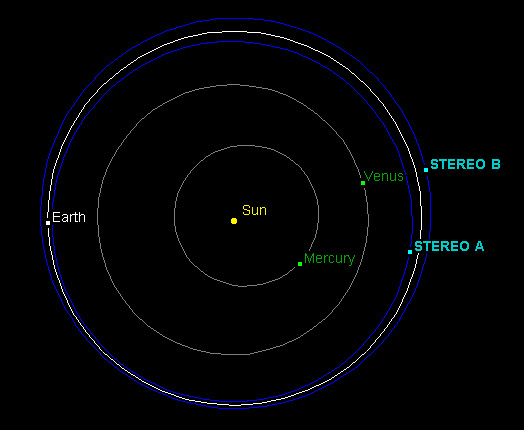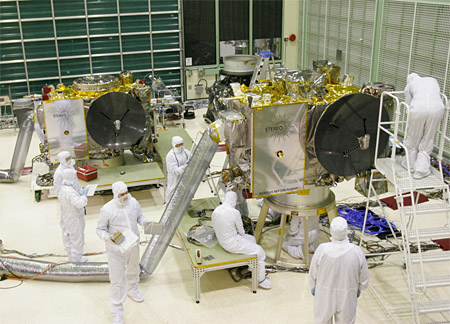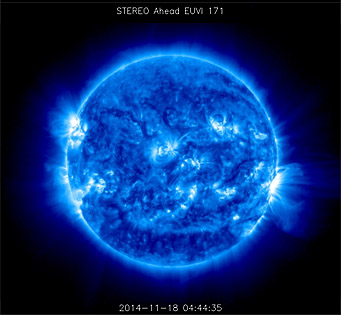Despite rescue efforts, no one has heard from one of two NASA spacecraft on the far side of the Sun since October 1st.
Solar physicists always worry about the damage to Earth that might occur if the Sun were to unleash a titanic flare and zap our planet with a potent blast wave of energetic particles. So, during the past two decades, NASA has launched a series of spacecraft designed to keep tabs on the Sun and the "space weather" it creates.

NASA / JPL Horizons
Key to this plan is Stereo, the Solar Terrestrial Relations Observatory. Launched in 2006, Stereo A looped around the Moon and swung into a heliocentric orbit "ahead" of Earth, while Stereo B took up a solar orbit "behind" the Earth. They provide views of the Sun and its surroundings from angles we can't see.
Both Stereo craft have drifted to the far side of the Sun, meaning that their dish-shaped radio antennas must point near the Sun to communicate with Earth. To protect these from overheating, mission controllers devised a plan to point each craft away from the Sun (and Earth) and to put it in safe-mode hibernation for about a year.
Tests of these new procedures took place over the past few months. Stereo A checked out fine and began its "time out" on August 20th. A month later engineers were completing Stereo B's final tests, which involved commanding the craft to go into its safe mode and then resume normal operations.Then something went wrong.

NASA / JHU-APL
There's been no radio contact with the Stereo B spacecraft since October 1st, the day it was supposed to "wake up". Its radio signal came in weakly and then quickly faded away. Up to that point, telemetry showed no indication that anything was amiss.
But now it appears that the spacecraft suffered a double whammy: first the star tracker could not lock onto its correct guide stars, and then a laser gyro in Stereo B's Inertial Measurement Unit, which senses the craft's orientation, failed and started providing bad data to the attitude-control system.
The upshot is that there's no way to know exactly where Stereo B is pointed or the state of its systems. Over the past few weeks, astronomers have been borrowing the giant, 100-meter-wide Green Bank Telescope to try to detect the spacecraft's radio signal, so far without success. The 70-m dishes of NASA's Deep Space Network are also trying to reestablish contact.

NASA / Goddard Space Flight Center
All hope is not lost. In 1998, the Solar and Heliospheric Observatory also went AWOL, putting itself in a slow spin with its solar-cell arrays pointed away from the Sun. Eventually, orbital geometry provided enough sunlight on the arrays, and enough electricity, to power the craft, and mission controllers eventually regained control. That was 16 years ago, and SOHO continues to provide daily images of the Sun and its surrounding.
But, at this point, recovery options are few. According to Joseph Gurman, Stereo project scientist at NASA's Goddard Space Flight Center, simulations are under way to deduce the spacecraft's attitude and roll rate based on the few final bits of telemetry received. NASA will then create a review board to brainstorm other recovery schemes — and to make sure this unexpected failure doesn't occur again In particular, they'll doublecheck the safe-mode programming of Stereo A, which will be out of contact with Earth for about four months beginning in March 2015.
Could Earth ever fall victim to a "solar superstorm"? Gets the odds of that happening — and the consequences if it does — in the February 2011 issue of Sky & Telescope.
 5
5









Comments
Anthony Barreiro
November 21, 2014 at 2:37 pm
Would it be possible to deploy a fleet of Sun-orbiting spacecraft with each craft staying at the same angle from Earth? E.g. two craft with one 120 degrees ahead of Earth and the other 120 degrees behind; or five craft, arrayed at 60 degree intervals around the Sun, with the spacecraft closer to Earth serving as relay stations for those on the far side of the Sun. Or do you need a big heavy planet's Lagrange point to hold a satellite in place?
And what about putting spacecraft into solar polar orbits? The NASA/ESA Ulysses probe did this, but it's no longer working.
You must be logged in to post a comment.
Peter Wilson
November 21, 2014 at 8:57 pm
Only the Lagrange points are stable. Wonder why they're not used? Losing these satellites in the sun for a year is unnerving.
A polar orbit requires a lot of fuel.
You must be logged in to post a comment.
Anthony Barreiro
November 24, 2014 at 5:16 pm
Thanks Peter. So we could use Earth's L3, L4, and L5 points, with L4 and L5 serving as relay stations for L3. And how about sending spacecraft to observe the Sun from the L1 points of the other inner planets? I think it would be lovely to be able to see how the Sun looks from Venus and Mars.
You must be logged in to post a comment.
Thomas Miller
November 28, 2014 at 6:30 pm
Just a thought; could Stereo A's Camera be used to detect Stereo B's rotation, location or signal?
You must be logged in to post a comment.
Roger-Keith
December 1, 2014 at 1:50 am
Was there a flight spare that could be launched into Stereo B's role?
You must be logged in to post a comment.
You must be logged in to post a comment.